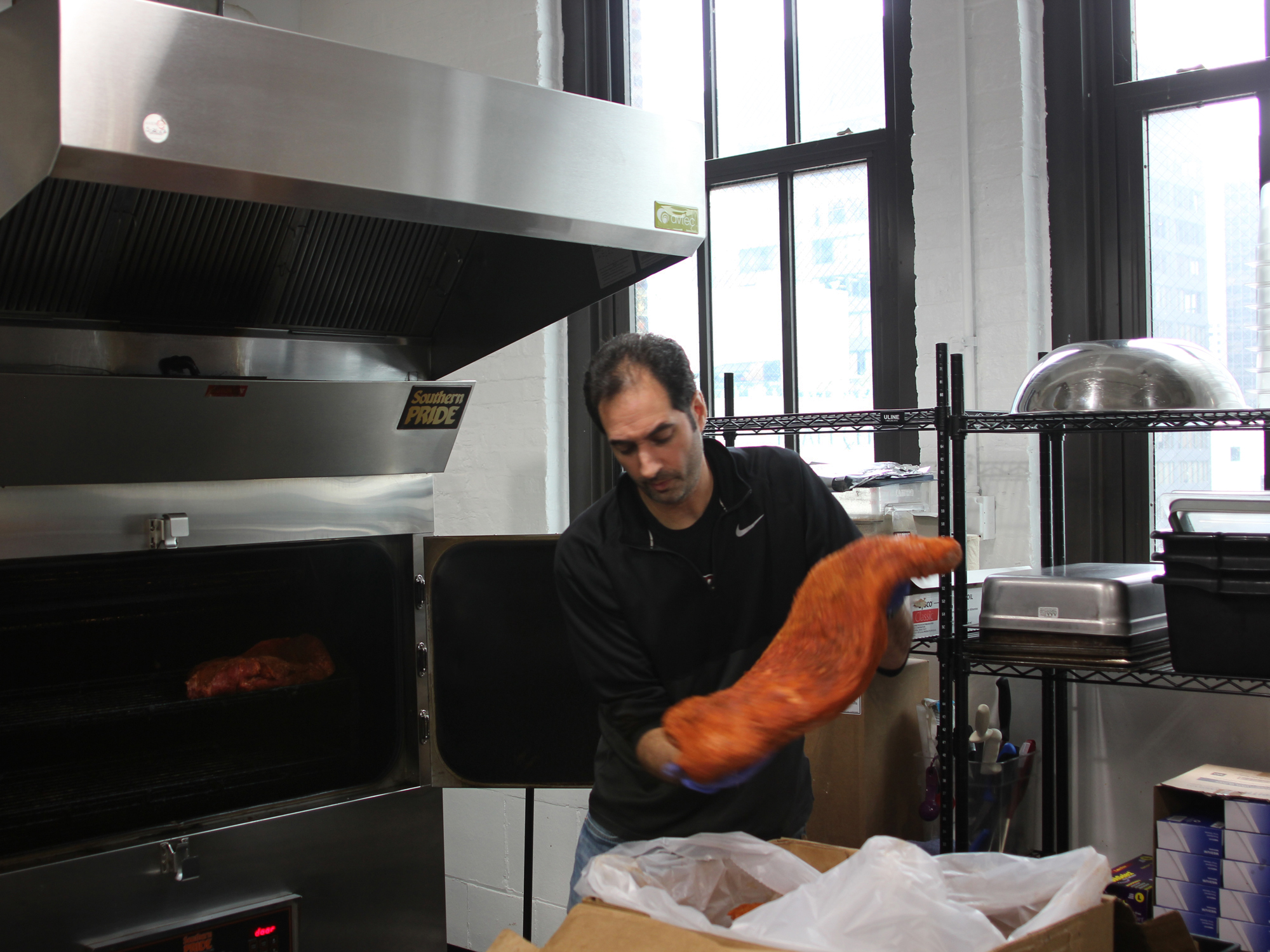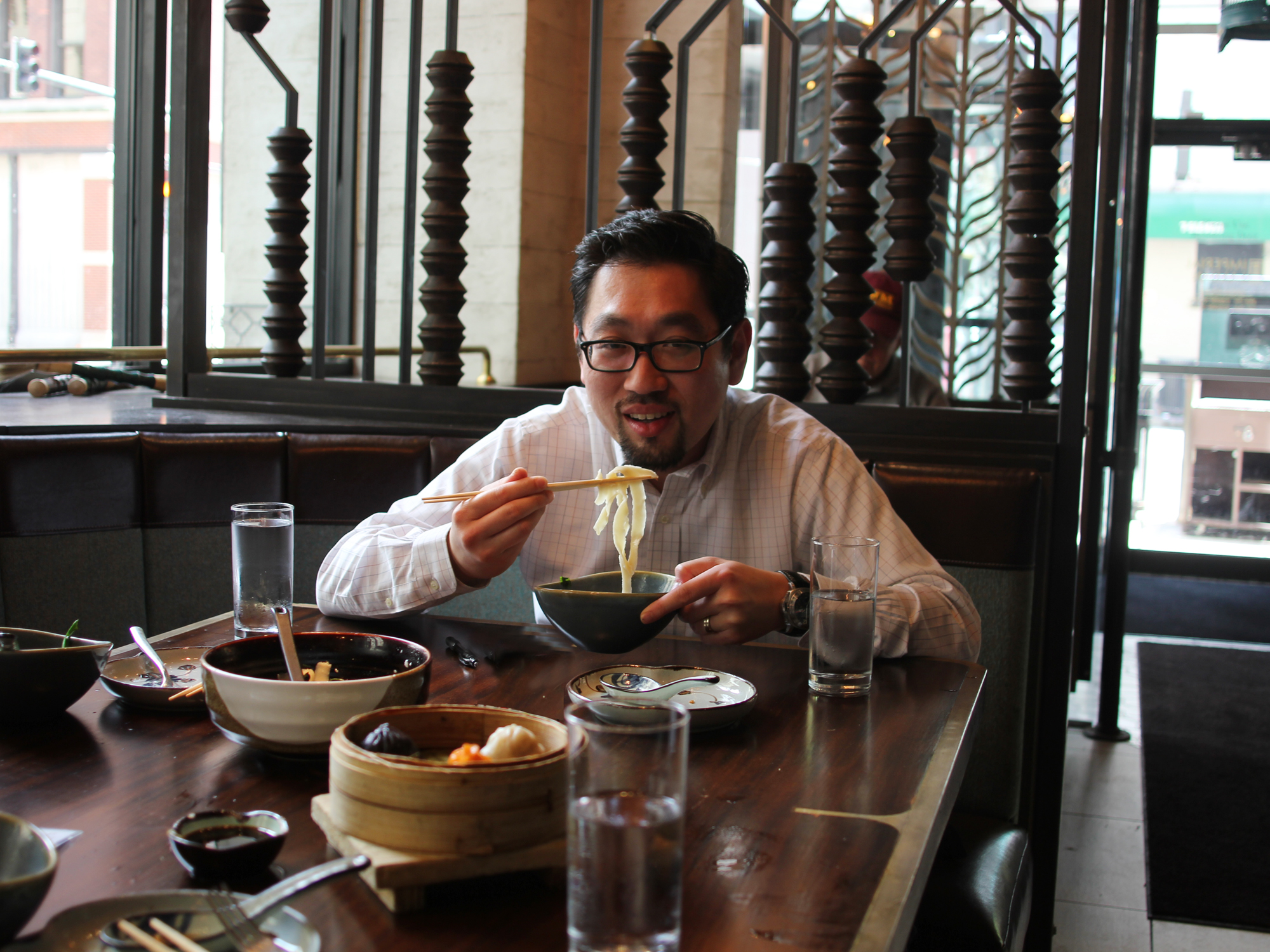WHAT THE PHRASE “STREET FOOD” MEANS has been explained to me by a number of chefs claiming inspiration from it. But I don’t think anyone has conjured up the picture of what it means better than Aishan “Damao” Zhong.
“I eat really little, I don’t have a big stomach, and my parents were really annoyed by how I eat,” Zhong says. “When I was young, I liked the small plate stuff, like the spicy potato strips—that was one of the famous foods on the street. People have the small cart, and just sell it to the students.”
“I really like that feeling. When I go home, after school, there’s tons of food, just on the street, and it’s very cheap. You can buy this and buy that, and walk and talk to your friends. It’s a very good memory of my childhood.”
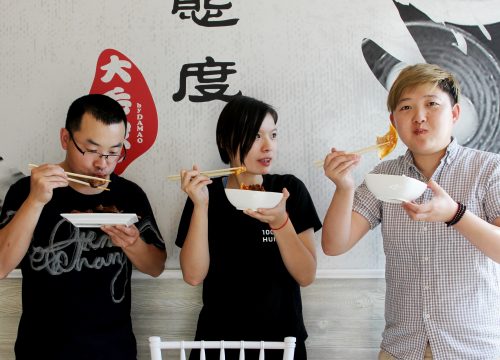
Qifeng Yu, Aishan “Damao” Zhong, and Mori Guo
The first bit of pocket money, and freedom from Mom and Dad, manifesting itself in the ability to pick the treat you want… it’s a treasured moment of growing up, whether you’re an American mallrat or Charlie Bucket dreaming of a Wonka bar. Or, in this case, a kid in Chengdu, Sichuan Province, China.
Now Aishan Zhong, or Damao (a childhood nickname), has brought her memories of Chengdu street food to a restaurant in a new strip mall west of Chinatown on Halsted. With her partner Mori Guo, she’s opened A Place By Damao, a tiny storefront seating about 20 people, specializing in the foods that people buy and gobble down on the street in Chengdu—simple and nearly all dunked in chili oil, for more of a deep, warming heat than the quick burn of fresh peppers, and often mixed with the metallic tang of Sichuan peppercorn. Some of it’s meaty things—braised duck necks, duck feet, chicken gizzards, fried pig ears, rabbit. Others are simple, carb-heavy dishes—pork dumplings, a bowl of fat handcut noodles, wontons in a volcanic-looking broth.

Potato strips
And then there’s the potato strips—which look, for all the world, like crinkle cut French fries, like they have at Superdawg. Zhong points out that they’re not double-fried like fries, so they have a stiffer potato texture, plus a ton of spicy stuff poured on top of them. The first time I went, with Strange Foods Festival founder Keng Sisavath and my family, I wouldn’t let my son order them—I didn’t want to set a precedent of ordering French fries in a Chinese restaurant—but honestly, having subsequently tried them, they’re pretty great. And the idea of Chinese schoolgirls, walking along gossiping and munching French fries spicy enough to peel the paint off your Buick, is charming.
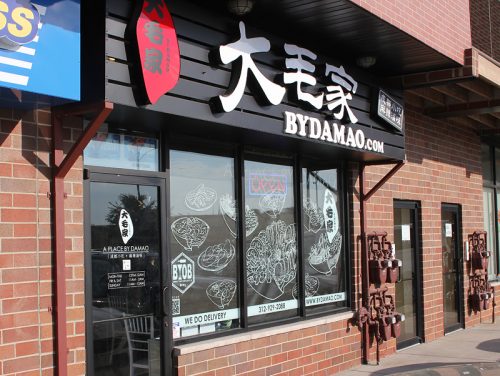
“SICHUAN IS FAMOUS FOR ITS FOOD, very spicy food. And pandas,” Zhong says. “It’s very chill and lazy. People love eating, and relaxing.”
Aishan Zhong came to the U.S. at 17, to study economics at the University of Wisconsin. “When I was there, I really missed my hometown, and my parents, and of course the food,” she says. “We have one or two Sichuan restaurants, but they are not authentic—the chefs are not even from Chengdu.” But at least there was a decent Asian grocer in Madison, so in her senior year, she started cooking the Sichuan food she missed in her apartment. “First, it’s not for commercial, it’s just for fun, for myself and for the friends around me,” she says. “My friends really liked my food, and they started to ask for more. They get really guilty, so they start to give me money—’It’s okay, this is just for the ingredients.'”
“So I started to think, this is a very good business. I have recipes, I have ingredients, and I have customers—I could do it.” She continued making extra money on the side cooking authentic Sichuan food as she finished up school. She came to Chicago to work, but she didn’t like corporate life—”You just sit in the office and talk to the same people every day and interact with the computers all the time.”
She started cooking at home for her friends. “It took about half a year to become a little bit famous, to where people around Chinatown, people I don’t know, heard about my food. That’s when I think I really could do this.”
I think the small plates street food is a culture of China. And this culture is actually disappearing.
She began looking for a partner to work with. She had met Mori when she first came to Chicago, and together they found a backer, who had been one of Damao’s catering customers, to back them in building out a restaurant in the newly constructed strip mall on Halsted, in a part of Bridgeport once off-limits to Chinese.
“I didn’t want to be in the Chinatown Square [mall], because I think that’s old, too many restaurants, too crowded. I like this place because it’s new,” home to only one other, very different Chinese restaurant—a Taiwanese restaurant called Taipei Cafe. “It’s very good that we both are here—they make very authentic Taiwanese food, we make very authentic Chengdu food. It’s good, because I want Americans to know that we have many, many different kinds of Chinese food.”
For her, the street food she likes is something distinct from even other Sichuan restaurants in Chinatown. “We have plenty of Chinese food here in Chicago—Chengdu restaurants, Sichuan restaurants. But those restaurants focus on the very big dishes,” she says, making her arms into a circle a foot across, “and they are almost twenty dollars. Sometimes it’s just too much.”

Wonton in hot soup
“I think the small plates street food is a culture of China,” Zhong says. “And this culture is actually disappearing. The reason is that this kind of food is not very expensive, so you cannot make a lot of money. They all want to make the superior, or very modern Chinese food, because they make money from them.”
But isn’t street food still a way to get started in the restaurant business, as food trucks are here? Zhong says not really: “In China, it’s developing so fast that people all want to just jump to the big step. If you look at a city from ten years ago, the buildings are just—growing and growing, very fast.”
“I go back to China like every year, but every time I go back, I can feel like—’Oh my God, those are new, and this is done.’ I couldn’t recognize some places,” she says.
I ask her to tell me about some of the classic street food dishes that they offer. First, she points on the menu (helpfully illustrated with cartoons of the dishes) to one called, with deceptive genericness, Sweet and Spicy Noodles. “These are the proudest thing that I can serve. This is a very special dish from Chengdu. I would guarantee that no one else serves this, in the United States even,” Zhong says. The fat, chewy noodles—two or three times thicker than even the shaved noodles you find at a few restaurants—come in a chili oil leavened with a note of sweetness and topped with peanuts. “Do you make the noodles?” I ask.
“We make the noodles, and then we cut them with a knife,” Zhong explains.
“It seems like everything comes in chili oil,” I say.
“Chengdu people, they like everything spicy,” she says. “I don’t know why, but it’s the history of Chengdu.”
“The weather is very wet. Moist,” Guo says. “They like the peppers.”
I point to another dish. “Now, something that not a lot of Americans eat is pork intestine.”
“That’s a very common dish for breakfast in China,” Zhong says. “Chinese, they eat for breakfast the noodles, and the rice in soup—congee.”

Handmade bell dumplings
The one thing we ordered a second helping of on that first visit was the bell dumplings—very simple, pork inside supple half-circle pockets of dough, swimming in chili oil. “Dumplings in China, they are very famous, but most Americans are talking about northern dumplings, like xiao long bao. Sichuan dumplings have a thicker skin,” Zhong says. “Because the skins taste good too, chewy, like the noodles. The meat inside is all pork, we don’t have any vegetables in there, that’s northern style. The flavor comes from the sauce on the outside—it’s similar to the noodles.”
“I noticed the sauce was different on some of them,” I say.
She points to the menu. “That one and that one,” meaning the thick noodles and the dumplings, “come with the Secret Sauce by Damao. It’s why you taste the sweetness.”
She leafs through the menu and finds another dish we’d had—kind of a stew bowl full of noodles, vegetables, sausage, tofu and more, which was so full of Sichuan peppercorn that all our mouths tingled for minutes afterwards. “This is like a transformation from hot pot—Chengdu people, they like hotpot, like, too much. And they want to eat hot pot, even one person,” she says. (It’s normally a communal activity, like Korean BBQ.) “So they developed this, so it can be eaten by one person. It’s actually our most popular dish.”
IT TURNS OUT THAT NEITHER MORI GUO nor the co-chef (with Zhong), Qifeng Yu, are from Chengdu—they’re both from the northern part of China. “I’m from close to Beijing,” Guo says. She also came here for college, “but I don’t like to study. I can work, I can earn money for myself, and I don’t want to ask my parents for money every month. I can take care of myself.”
“In China’s north, people like spicy, but not really spicy, like Chengdu,” Guo says. “But when she cooked really spicy for me, I liked it and I could eat it.”
Yu is also from the north near Beijing. “Before I came here, I never see this type of noodle,” he says, pointing to the thick handcut noodles. “A different taste and a different feeling. Before I came here, I never ate Chengdu food. I’m very fortunate now to eat the Chengdu food.”
“But Chengdu is known for two things,” he says. “One is beautiful girls, and the other is delicious food.”
“Did they teach you how to cook Chengdu food?”
“Actually, before I came here I wasn’t good at cooking,” he says. “You know what my major was? Civil engineering. But food is always interesting for people, right? And both of them teach me, from the beginning.”
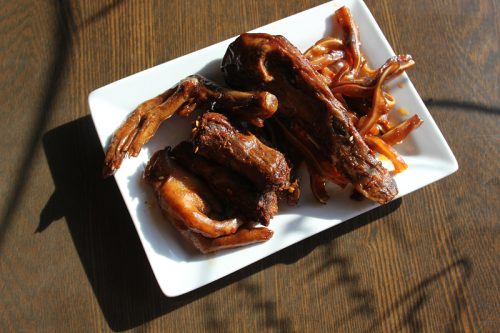
Braised duck feet, tongue, and head, and fried pig ear
“Before we started [the restaurant], we cook in a shared kitchen,” Guo says. “I go to learn to cook, and got the manager license.” A mentor in the Chinese community urged them to quickly get past catering and open a restaurant. “He thinks we’re going to be really popular, because we sell duck necks. Nobody sells them in Chicago,” she says.
“It’s a snack, like the way Americans eat chicken wings,” Zhong explains. “When you want to watch some TV with friends, you eat the duck necks. It has a lot of bones, it keeps you busy.”
“Before I managed the restaurant, I was a manager at a nail salon,” Guo says. “I quit my job—”
“I said, just quit there. This is more fun,” Zhong says.
“Has it been more fun?” I ask.
“Yeah, of course,” Guo says. “If you work at a nail salon, you have to get up every morning to go to work at nine, and you get off every night at nine. Right now, I do this business with her, the time is more flexible.”
Though not shorter, I’m sure—the restaurant is open at least 9 to midnight five days a week, and 11 to 2 am Friday and Saturday. But having seen them at work on a Saturday night, with a line out the door and a packed house (entirely Chinese except for us) chowing down diligently on spicy noodle dishes and braised duck parts, the business of bringing authentic Chengdu street food to Chicago looks like it’s very satisfying to Damao and her converts to Sichuan food from the north.
“That’s my proudest thing to say,” Zhong says. “I cook the real Chengdu food, and I got approval from real Chengdu people. I really want to make the taste like how it was. I won’t change it to suit American’s appetites. I won’t change it even to suit northern peoples’ appetite. I just like it how it is.”
How to Eat a Duck Head and Duck Feet, Demonstrated by Mori Guo
Michael Gebert is head duck as editor of Fooditor.
Latest
Join the Discussion
After you comment, click Post. If you're not already logged in you will be asked to log in or register with Disqus.













